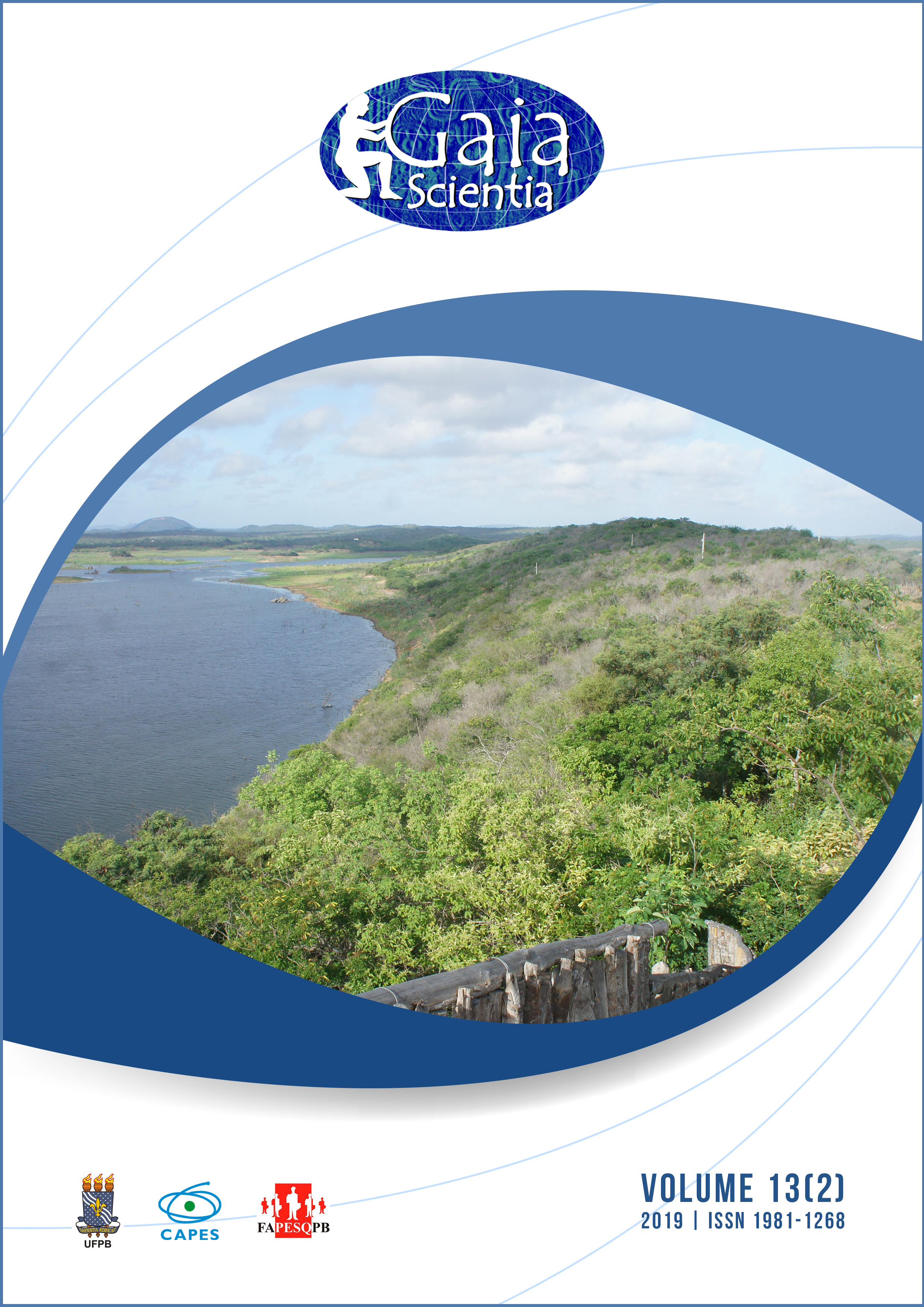Gauging the acceptance and the attitudes of rural workers in the semiarid region of northeastern Brazil concerning the artisanal production and consumption of Spirulina platensis
DOI:
https://doi.org/10.22478/ufpb.1981-1268.2019v13n2.33281Resumo
The purpose of this study was evaluate the acceptability of S. platensis in feeding of seventy-five rural workers in the municipality of Frei Martinho, semiarid region of Paraíba, Brazil. It was evaluated their attitudes in terms of the possibility of cultivating that microalgae, if they would be open to dietary changes (innovative attitudes) or refractory to it (conservative attitudes), and their attitudes towards possible artisanal cultivation of S. platensis. The biomass produced in laboratory cultures was used for producing cakes, juices, and cookies; in natura or dried materials were also tested for acceptability, as well as their purchase intention of products based on Spirulina. Acceptability index higher than expected (70%) were observed for all of the attributes evaluated (appearance, odor, and texture) in three different presentations (“in natura”, dried, and incorporated into foods), except for the odor in the in natura form (66.12%). In terms of purchase intention, 88% of the respondents confirmed that they would buy supplemented products if they were available. The attitude tests showed a consistent internal positive view of Spirulina, indicating that the agricultural workers were open to technological innovations.
Downloads
Referências
Belay A, Ota Y, Miyakawa K, Shimamatsu H. 1993. Current knowledge on potential health benefits of Spirulina. Journal of Applied Phycology, 5: 235-241.
Belay A. 2002. The Potential Application of Spirulina (Arthrospira) as a Nutritional and Therapeutic Supplement in Health Management. Journal of the Academy of Nutrition and Dietetics, 5:27-49.
Brasil. 2003. Ministério da Agricultura, Pecuária e Abastecimento. Secretaria de Defesa Agropecu¬ária (Dispoa). Instrução Normativa n° 62, de 26 de agosto de 2003. Métodos analíticos oficiais para análises microbiológicas para controle de produtos de origem animal e água. Diário Oficial da União. Brasília.
El-Dash A and Germani R. 1994. Tecnologia de Farinhas Mistas: Uso de Farinhas Mistas na Produção de Biscoitos. Brasília: EMBRAPA – SPI 6.
El-Sayed AFM. 1994. Evaluation of soybean meal, spirulina meal and chicken offal meal as protein sources for silver seabream (Rhabdosargus sarba) fingerlings. Aquaculture, 127:169–176.
FAO. 2008. The state of food and agriculture. Biofuels: prospects, risks and opportunities. Food and Agriculture Organization of the United Nations. Rome.
Habib MAB, Parvin M, Huntington TC and Hasan MR. 2008. A review on culture, production and use of spirulina as food for humans and feeds for domestic animals and fish. FAO Fisheries and Aquaculture Circular 1034.
Henrikson R. 2009. Earth Food Spirulina: How this remarkable blue-green algae can transform your health and our planet. Ronore Enterprises, California.
Henrikson R. 2010. Spirulina World Food: How this microalgae can transform your health and our planet? Ronore Enterprises, California.
Hoff FH and Snell TW. 2009. Plankton Culture Manual. 5 ed. Dade City: Florida.
Ardiet D and Weid D. 2007. Spirulina as a food complement for health and cognitive development, Antenna Technologies. http://www.antenna.ch/en/medias/Nutrition-et-d%C3%A9veloppement-cognitif_Antenna-Technologies_2007.pdf. Accessed 18 December 2015.
FDA. 2002. GRAS Notification for Spirulina Microalgae http://www.fda.gov/downloads/Food/IngredientsPackagingLabeling/GRAS/NoticeInventory/UCM265861 Accessed 15 December 2015.
Koníčková R, Vaňková K, Vaníková J, Váňová K, Muchová L, Subhanová I, Zadinová M, Zelenka J, Dvořák A, Kolář M, Strnad H, Rimpelová S, Ruml T, J Wong R, Vítek L. 2014 Anti-cancer effects of blue-green alga Spirulina platensis, a natural source of bilirubin-like tetrapyrrolic compounds. Annals of Hepatollogy, Mar-Apr 13:273-83.
Layam A and Reddy CLK. 2007. Antidiabetic property of Spirulina. Diabetologia Croatica, 35:29-33.
Mao TK, Van de Water J and Gershwin ME. 2003. Effect of Spirulina on the secretion of cytokines from peripheral blood mononuclear cells. Journal of Medicinal Food, 3:135-140.
Mohan IK, Khan M, Shobha JC, Naidu MUR, Prayag A, Kuppusamy P and Kutala VK. 2006. Protection against cisplatin-induced nephrotoxicity by Spirulina in rats. Cancer Chemotherapy and Pharmacology, 58(6):802–808.
Moorhead, K, Capelli, B and Cysewski, GR. 2006. Spirulina Nature's Superfood. Cyanotech Corporation.
Morais MG, Miranda MZ and Costa JAV. 2006. Biscoitos de chocolate enriquecidos com Spirulina platensis: características físico-químicas, sensoriais e digestibilidade. Alimentos e Nutrição, 17:323-328
Juárez-Oropeza MA, Mascher D, Torres-Durán PV, Farias JM and Paredes-Carbajal MC. 2009. Effects of dietary Spirulina on vascular reactivity. Journal of Medicinal Food, 12: 15-20.
Ozdemir G, Karabay NU, Dalay MC and Pazarbasi B. 2004. Antimicrobial activity of volatile component and various extracts of Spirulina plantensis. Phytotherapy Research, 18:754–757.
Prasad CS. 2005. Science and Technology in Civil Society Innovation Trajectory of Spirulina Algal Technology. Economic and Political Weekly, 4063- 3372.
Ramakrishnan R. 2013. Antiviral properties of cyanobacterium, Spirulina platensis- A review. International Journal of Medicine and Pharmaceutical Sciences, 3: 1-10.
Simpore J, Kabore F, Zongo F et al. 2006. Nutrition Rehabilitation of Undernourished Children Utilizing Spiruline and Misola. Nutrition Journal, 5:3.
Sotiroudis TG and Sotiroudis GT. 2013. Health aspects of Spirulina (Arthrospira) microalga food supplement. Journal of the Serbian Chemical Society, 78:395 – 405.
Stone H and Sidel J. 1993. The role of sensory evaluation in the industry. Food Quality and Preference, 4(2):65-73.
Teixeira E, Meinert EM e Barbetta PA. 1987. Análise sensorial de alimentos. Editora da UFRS Florianópolis.
Thompson SCG and Barton MA. 1994. Ecocentric and anthropocentric attitudes toward the environment. Journal of Environmental Psychology, 14:149-157.
Yang HN, Lee EH and Kim HM. 1997. Spirulina platensis inhibits anaphylactic reaction. Life Sciences, 61(13):1237 – 1244.
Zarrouk C. 1966. Contribution l’e´tude d’une cyanophyce : influence de divers facteurs physiques et chimiques sur la croissance et la photosynthe`se de Spirulina maxima (Setch et Gardner) Geitler. Thesis (PhD), Faculty of Science, University of Paris.
Zeenat R, Sharma VK and Rizvi Z. 1990. Synergistic effect of cyanobacteria and DAP on tomato yield. Science and Culture, 56:129–131.










